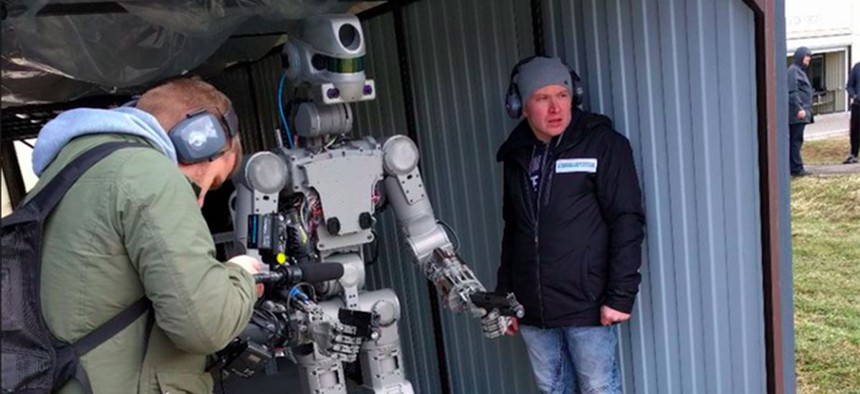Russia May Put Androids in Orbit Next Year, State Media Says

The FEDOR robot is trained to shoot guns. Twitter/Dmitry Rogozin
The mission would be the latest for FEDOR, created for rescue work — and more recently given the ability to shoot guns.
The International Space Station should prepare for the arrival of its first android crew members, Russian state media says. The Roskosmos space agency has approved a preliminary plan to send a pair of humanoid robots called FEDOR into space in August 2019, according to “a source in the space and rocket industry” quoted by the RIA Novosti website.
Robots in space have become commonplace for space superpowers: the U.S. has two operational Mars rovers, China has a lunar lander on the moon and more on the way, and Russia has several now-defunct rovers on both the moon and Mars. In 2011, NASA sent Robonaut 2, a 330-pound manually controlled “humanoid” robot, to the ISS to look into how such robots might be used to perform simple, repetitive, or especially dangerous tasks.
But while previous robots were shot into space as cargo, Russia’s pair of FEDORs — the acronym stands for Final Experimental Demonstration Object Research — will “fly for the first time to the ISS as crew members, and not as cargo in the transport compartment,” RIA Novosti wrote, adding that the robots will fly in an otherwise unmanned Soyuz rocket. State media called this a “good PR move.”
Originally designed for rescue work, FEDOR has since been given the ability to perform various human-like actions such as push-ups, lifting weights, power drilling, driving, and fist-bumping.In 2017, FEDOR added shooting guns to its repertoire. Deputy Prime Minister Dmitry Rogozin subsequently took to Twitter to deny that FEDOR “was a Terminator” but instead part of a larger effort to develop artificial intelligence for “practical significance in various fields.”
“This was initially designed as a proof of concept — and the space role for this robot was implied from the beginning. It does make for a very effective military ‘android’ in official videos where its shooting guns, but ultimately it’s a dual-use work frame for hard-to-do projects like working in space or in other hazardous environments,” noted Sam Bendett, an associate research analyst at CNA and a fellow in Russia studies at the American Foreign Policy Council.
NASA has a six-foot humanoid robot of its own. Also originally designed for disaster relief, R5 — aka Valkyrie — has been undergoing tests over the past few years that simulate space environments. In 2017, Valkyrie demonstrated its skills in repairing structures as part of a simulation in which a Mars structure is damaged by a dust storm.
NASA has not released any official plans to send Valkyrie into space, but V. Kris Verdeyen, one of Valkyrie’s engineers, recently expressed hope in an article in Science Robotics that robots like Valkyrie, with human-like skills, “could replace astronauts in more dangerous situations on spacecraft.” The engineer pushed for NASA to develop a fleet of autonomous Star Wars-style droids to help astronauts in space.
Might there be another reason, beyond PR, to put the robots in the main cabin instead of the trunk? Since the shuttering of the Space Shuttle program, American astronauts’ only ride to orbit has been aboard Russia’s Soyuz rockets. An effort to put new American-made crew compartments into service by fall 2019 appears to be delayed. Will FEDOR bump U.S. astronauts from their flights?
Patrick Tucker contributed reporting to this story.
NEXT STORY: DARPA’s New Cars Are Mechanical Mountain Goats





